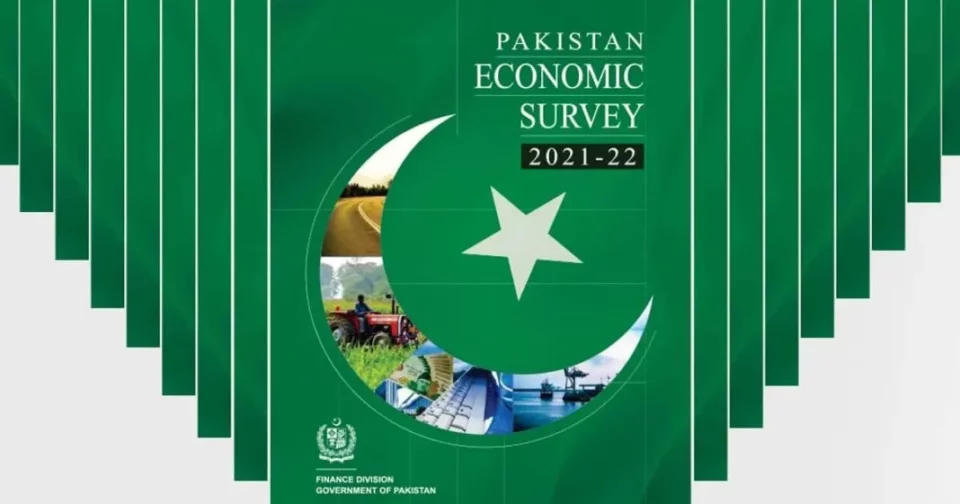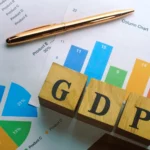Pakistan’s GDP grows 20% to $383 billion, and per capita income is recorded at $1,798: Economic Survey reveals
Federal Finance Minister Miftah Ismail unveiled the annual Economic Survey for the fiscal year 2021-22 on Thursday, acknowledging Pakistan’s structural economic challenges but saying the country had historically always experienced current account deficits after undergoing economic growth but was now “headed toward stability.”
The Economic Survey is a document released each year a day before the presentation of the federal budget to outline the economic performance during the outgoing fiscal year.
Finance Minister Miftah Ismail will present the budget on Friday, as the country tackles a stuttering economy with huge deficits, dwindling foreign reserves, a widening current account deficit, and inflation in the double digits.
“As soon as the economy starts growing, the current account deficit goes out of control, and [the nation] begins to face [exchange rate] and balance of payment crises,” the finance minister said at a press conference in Islamabad.
According to Pakistan Economic Survey 2021-22, the GDP at the current market rate stood at Rs66,950 billion after a growth of 20 percent in comparison to the previous year. In dollar terms, it remained at $383 billion.
The agriculture sector posted growth of 4.4%, Industry 7.2%, services sector 58%, and large scale manufacturing 10.4% in FY2021-22.
The document also informed that Pakistan’s per capita income was recorded at $1,798 during FY2022, reflecting an improvement in the overall economic prosperity of the country.
The finance minister said that Pakistan’s economic woes were mainly caused by its growing imports which were likely to reach around $77 billion by the end of the new fiscal year.
“Pakistan’s imports have rapidly increased and have gone up by about 48 percent in comparison to the last year,” he added. “While our exports have grown as well, they have only increased by 28 percent. So, the trade deficit has reached $45 billion.”
Ismail said Pakistan’s forex reserves would rise to more than $12 billion after it receives some $2.4 billion from China in the next two to three days. “We are very grateful to China as we are about to receive $2.4 billion from them in the next few days,” he said.
Read More: Pakistan’s GDP jumps to 6pc in FY2021-22
Pakistan’s forex reserves currently stand at $9.7 billion, or enough to cover less than 45 days of its imports. However, the finance minister said the country was not facing a threat of default on its financial commitments.
“We have avoided the imminent default that Pakistan was facing and … we are headed toward stability,” he maintained. “We will ensure Pakistan grows with sustainability … a growth where we will not face a balance of payment crisis.”
According to the survey document, the total public debt of the country stood at Rs44.36 trillion by the end of March, including domestic and external debt of Rs28.07 trillion and $88.8 billion (Rs16.29 trillion), respectively.
“Pakistan’s strategy to reduce its debt burden to a sustainable level includes a commitment to run primary surpluses, maintain low and stable inflation, promote measures that support higher long-term economic growth and follow an exchange rate regime based on economic fundamentals,” said the document.
“With a narrower fiscal deficit, public debt is projected to enter a firm downward path, while the Government’s efforts to improve maturity structure will enhance public debt sustainability,” it continued.
Foreign media reported that Pakistan’s federal budget will be closely watched by the IMF whose board has to clear the seventh review to resume a $6 billion rescue package signed in 2019. Bailout talks in Doha last month ended without a breakthrough.
Previously, Ismail promised an effective strategy to achieve GDP growth of up to 6 percent that would also help control inflation with strategic measures while addressing a day-long Pre-Budget Business Conference this week.
“We have prepared a very progressive budget which you will see but we are going to do fiscal consolidation,” he said. Various estimates suggest the government will set a total budget outlay of between Rs9 trillion to Rs9.5 trillion for the next fiscal year.
Speaking at the occasion, Planning Minister Ahsan Iqbal accused the previous government of not giving due significance to the multibillion-dollar China-Pakistan Economic Corridor (CPEC) while pointing out that the government was “reviewing it and taking other initiatives to improve the condition of the country’s least developed areas.”
According to the survey document, Pakistan and China have successfully launched 56 projects under the framework. “Out of these projects, 26 projects worth approximately $17 billion has been completed so far and 30 projects worth $8.5 billion are under construction,” it said.
The document also pointed out that Pakistan’s inflation from July to April of the outgoing fiscal year was recorded at 11 percent, compared to the targeted 8 percent, due to an increase in global commodity prices including crude and edible oils.
“The pressures on headline inflation can fairly be attributed to adjustment in prices of electricity and gas, a significant increase in the non-perishable food prices, exchange rate depreciation along with the rapid increase in global fuel and commodity prices,” it added. Inflation in the country was recorded at 13.8 percent in May, 13.4 percent in April, and 10.9 percent in May 2021.
Economic survey at a glance
– The real GDP posted a growth of 5.97pc
– For July-April FY2022, the current account deficit remained $13.8 billion against the deficit of $0.5 billion last year
– Investment to GDP ratio remained 15.1pc compared to 14.6pc recorded in FY2021.
– The agriculture sector posted growth of 4.4pc mainly due to 6.6pc growth in crops and 3.3pc growth in livestock.
– Industrial sector recorded a growth of 7.2pc in FY2022 compared to 7.8pc growth in FY2021.
– Services sector still constitutes the largest share of 58pc in GDP.
– Large Scale Manufacturing (LSM) growth during July-March FY2022 increased by 10.4pc as compared to 4.2pc growth in the same period last year.
– Total revenues increased by 17.7pc and reached Rs 5,874.2 billion (8.8pc of GDP) in July-March FY2022 against Rs 4,992.6 billion (8.9pc of GDP) last year.
– Total tax collection (Federal & Provincial) grew by 28.1pc to reach Rs 4,821.9 billion during July-March FY2022 as compared to Rs 3,765.0 billion in the comparable period of last year.
– Non-tax revenues, on the other hand, fell 14.3pc to Rs 1,052.2 billion in July-March FY2022, compared to Rs 1,227.6 billion in the same period the previous year.
– Total expenditures grew by 27.0pc to reach Rs 8,439.8 billion in July-March FY2022 against Rs 6,644.6 billion last year.
– Current expenditures grew by 21.2pc to Rs 7,378.0 billion during July-March FY2022 as compared to Rs 6,085.4 billion in the comparable period of last year.
– Total development expenditure increased significantly by 54.6pc to Rs 1,032.7 billion in July-March FY2022 against Rs 668.0 billion in the comparable period of last year.
– The federal PSDP grew by 28.1pc to Rs 452.3 billion during July-March FY2022 against Rs 353.0 billion last year.
– FBR tax collection during July-May FY2022 increased by 28.4pc to Rs 5,348.2 billion against Rs 4,164.3 billion last year.
– During July-March FY2022, all the four provinces posted a combined surplus of Rs 599.8 billion against Rs 412.7 billion in the same period of last year.
– The fiscal deficit increased to 3.8pc of GDP (Rs 2,565.6 billion) during July-March FY2022 against 3.0pc of GDP (Rs 1,652.0 billion) in the same period of last year.
– The primary balance posted a deficit of Rs 447.2 billion against the surplus of Rs 451.8 billion during the period under review.
– During the period 1st July-20th May FY2022, the Net Domestic Assets (NDA) of the banking system witnessed an expansion of Rs 3,075.2 billion as compared to an expansion of Rs 645.7 billion during the comparable period last year.
– The benchmark KSE-100 index opened at 47,356 points on July 1, 2021, closed at 44,929 points on March 31, 2022, and declined by 5.1pc in the first nine months of FY2022.
– The headline inflation CPI averaged 11.3pc during July-May FY2022 against 8.8pc in the comparable period last year.
– During July–April FY2022, the exports grew remarkably by 27.8pc and reached $ 26.8 billion dollars as compared to $ 21.0 billion in the same period last year.
– Imports stood at $ 59.8 billion in July-April FY2022 as compared to $43.0 billion in the same period last year growing by 39.0pc. The increase in imports is recorded in all the major groups.
– Trade deficit increased by 49.6pc in July-April FY2022 to $ 32.9 billion as compared to $ 22.0 billion in the corresponding period last year.
– From July-April FY2022, the current account posted a deficit of $ 13.8 billion against a deficit of $ 543 million last year.
– Total public debt was Rs 44,366 billion at the end-March 2022.
– Domestic debt was Rs 28,076 billion and external public debt was Rs 16,290 billion or $ 88.8 billion at the end of March-2022.
– Total labor force is 71.76 million, out of which 67.25 million are employed and 4.51 million are unemployed.
– Import bill of oil increased by 95.9pc to $17.03 billion during July-April FY2022 compared to $8.69 billion during the same period last year.


